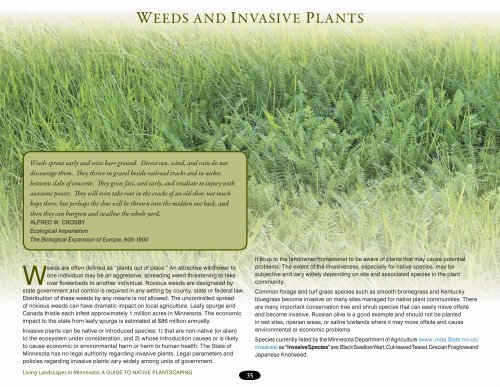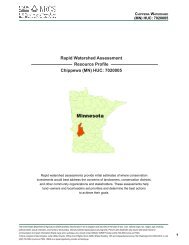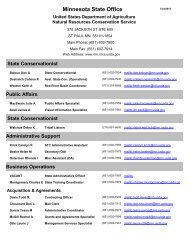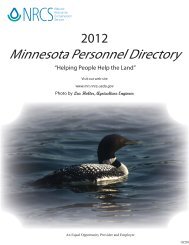Living Landscapes in Minnesota: - Minnesota NRCS - US ...
Living Landscapes in Minnesota: - Minnesota NRCS - US ...
Living Landscapes in Minnesota: - Minnesota NRCS - US ...
You also want an ePaper? Increase the reach of your titles
YUMPU automatically turns print PDFs into web optimized ePapers that Google loves.
Weeds sprout early and seize bare ground. Direct sun, w<strong>in</strong>d, and ra<strong>in</strong> do not<br />
discourage them. Th ey thrive <strong>in</strong> gravel beside railroad tracks and <strong>in</strong> niches<br />
between slabs of concrete. Th ey grow fast, seed early, and retaliate to <strong>in</strong>jury with<br />
awesome power. Th ey will even take root <strong>in</strong> the cracks of an old shoe: not much<br />
hope there, but perhaps the shoe will be thrown <strong>in</strong>to the midden out back, and<br />
then they can burgeon and swallow the whole yard.<br />
ALFRED W. CROSBY<br />
Ecological Imperialism<br />
The Biological Expansion of Europe, 900-1900<br />
Weeds are often def<strong>in</strong>ed as “plants out of place.” An attractive wildflower to<br />
one <strong>in</strong>dividual may be an aggressive, spread<strong>in</strong>g weed threaten<strong>in</strong>g to take<br />
over flowerbeds to another <strong>in</strong>dividual. Noxious weeds are designated by<br />
state government and control is required <strong>in</strong> any sett<strong>in</strong>g by county, state or federal law.<br />
Distribution of these weeds by any means is not allowed. The uncontrolled spread<br />
of noxious weeds can have dramatic impact on local agriculture. Leafy spurge and<br />
Canada thistle each <strong>in</strong>fest approximately 1 million acres <strong>in</strong> M<strong>in</strong>nesota. The economic<br />
impact to the state from leafy spurge is estimated at $86 million annually.<br />
Invasive plants can be native or <strong>in</strong>troduced species: 1) that are non-native (or alien)<br />
to the ecosystem under consideration, and 2) whose <strong>in</strong>troduction causes or is likely<br />
to cause economic or environmental harm or harm to human health. The State of<br />
M<strong>in</strong>nesota has no legal authority regard<strong>in</strong>g <strong>in</strong>vasive plants. Legal parameters and<br />
policies regard<strong>in</strong>g <strong>in</strong>vasive plants vary widely among units of government.<br />
<strong>Liv<strong>in</strong>g</strong> <strong>Landscapes</strong> <strong>in</strong> M<strong>in</strong>nesota: A GUIDE TO NATIVE PLANTSCAPING<br />
WEEDS AND I NVASIVE PLANTS<br />
35<br />
It is up to the landowner/homeowner to be aware of plants that may cause potential<br />
problems. The extent of the <strong>in</strong>vasiveness, especially for native species, may be<br />
subjective and vary widely depend<strong>in</strong>g on site and associated species <strong>in</strong> the plant<br />
community.<br />
Common forage and turf grass species such as smooth bromegrass and Kentucky<br />
bluegrass become <strong>in</strong>vasive on many sites managed for native plant communities. There<br />
are many important conservation tree and shrub species that can easily move offsite<br />
and become <strong>in</strong>vasive. Russian olive is a good example and should not be planted<br />
<strong>in</strong> wet sites, riparian areas, or sal<strong>in</strong>e lowlands where it may move offsite and cause<br />
environmental or economic problems.<br />
Species currently listed by the M<strong>in</strong>nesota Department of Agriculture (www..mda.State.mn.us/<br />
<strong>in</strong>vasives) as “Invasive Species” are: Black Swallow Wart, Cut-leaved Teasel, Grecian Foxglove and<br />
Japanese Knotweed.






